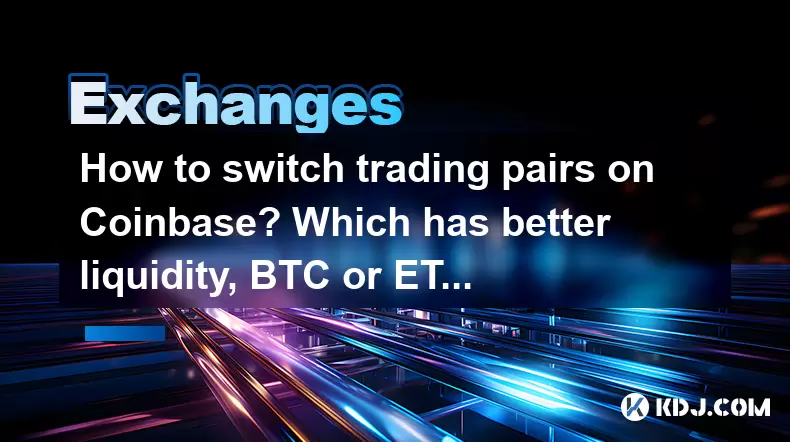-
 Bitcoin
Bitcoin $117500
2.15% -
 Ethereum
Ethereum $3911
6.19% -
 XRP
XRP $3.316
10.79% -
 Tether USDt
Tether USDt $1.000
0.01% -
 BNB
BNB $787.2
2.24% -
 Solana
Solana $175.2
4.15% -
 USDC
USDC $0.9999
0.00% -
 Dogecoin
Dogecoin $0.2225
8.40% -
 TRON
TRON $0.3383
0.28% -
 Cardano
Cardano $0.7868
6.02% -
 Stellar
Stellar $0.4382
9.34% -
 Hyperliquid
Hyperliquid $40.92
7.56% -
 Sui
Sui $3.764
7.63% -
 Chainlink
Chainlink $18.48
10.66% -
 Bitcoin Cash
Bitcoin Cash $582.1
1.88% -
 Hedera
Hedera $0.2601
6.30% -
 Avalanche
Avalanche $23.33
4.94% -
 Ethena USDe
Ethena USDe $1.001
0.02% -
 Litecoin
Litecoin $122.3
2.04% -
 UNUS SED LEO
UNUS SED LEO $8.969
-0.27% -
 Toncoin
Toncoin $3.339
0.86% -
 Shiba Inu
Shiba Inu $0.00001287
4.30% -
 Uniswap
Uniswap $10.43
7.38% -
 Polkadot
Polkadot $3.861
5.08% -
 Dai
Dai $1.000
0.02% -
 Bitget Token
Bitget Token $4.513
3.41% -
 Monero
Monero $267.7
-6.18% -
 Cronos
Cronos $0.1499
4.14% -
 Pepe
Pepe $0.00001110
5.15% -
 Aave
Aave $284.9
8.28%
How to switch trading pairs on Coinbase? Which has better liquidity, BTC or ETH?
Switching trading pairs on Coinbase is easy: log in, go to "Trade," select your pair, review details, and place your order. Consider liquidity and fees when choosing.
May 17, 2025 at 04:49 pm

Trading pairs are an essential part of cryptocurrency trading, allowing users to exchange one cryptocurrency for another. On Coinbase, one of the most popular cryptocurrency exchanges, users can switch between various trading pairs to optimize their trading strategies. In this article, we will guide you through the process of switching trading pairs on Coinbase and discuss the liquidity of two major cryptocurrencies, Bitcoin (BTC) and Ethereum (ETH).
Understanding Trading Pairs on Coinbase
Before diving into the process of switching trading pairs, it's important to understand what trading pairs are. A trading pair consists of two cryptocurrencies that can be traded against each other. For example, the BTC/USD trading pair allows you to buy or sell Bitcoin (BTC) using US Dollars (USD). Coinbase offers a variety of trading pairs, including BTC/USD, ETH/USD, LTC/USD, and more.
How to Switch Trading Pairs on Coinbase
Switching trading pairs on Coinbase is a straightforward process. Here's a step-by-step guide on how to do it:
- Log in to your Coinbase account. If you don't have an account, you'll need to create one and complete the necessary verification steps.
- Navigate to the "Trade" section. This can usually be found in the top navigation menu or on the main dashboard.
- Select the trading pair you want to switch to. Coinbase will display a list of available trading pairs. Click on the pair you want to trade, such as BTC/ETH or ETH/BTC.
- Review the trading pair details. Before proceeding, take a moment to review the current market price, order book, and trading volume for the selected pair.
- Place your trade. Once you've selected the desired trading pair, you can place a buy or sell order according to your trading strategy.
Factors to Consider When Switching Trading Pairs
When deciding which trading pair to switch to, consider the following factors:
- Liquidity. Higher liquidity means you can buy or sell larger amounts of cryptocurrency without significantly impacting the market price. We'll discuss the liquidity of BTC and ETH in more detail later.
- Volatility. Some trading pairs may be more volatile than others, which can present both opportunities and risks for traders.
- Trading fees. Coinbase charges different fees for different trading pairs, so be sure to check the fee structure before switching.
- Market trends. Keep an eye on market trends and news that may affect the performance of specific cryptocurrencies.
Liquidity Comparison: BTC vs. ETH
Liquidity is a crucial factor to consider when choosing a trading pair. Let's compare the liquidity of Bitcoin (BTC) and Ethereum (ETH), two of the most popular cryptocurrencies on Coinbase.
- Bitcoin (BTC). Bitcoin is the oldest and most widely recognized cryptocurrency, which contributes to its high liquidity. The BTC/USD trading pair on Coinbase typically has a large order book and high trading volume, making it easy to buy and sell large amounts of Bitcoin without significantly impacting the market price.
- Ethereum (ETH). Ethereum is the second-largest cryptocurrency by market capitalization and is known for its smart contract functionality. While ETH has lower liquidity compared to BTC, it still maintains a relatively high level of liquidity on Coinbase. The ETH/USD trading pair is popular among traders and has a substantial order book and trading volume.
Which Has Better Liquidity: BTC or ETH?
When comparing the liquidity of BTC and ETH on Coinbase, Bitcoin generally has better liquidity. This is due to several factors:
- Market dominance. Bitcoin's position as the leading cryptocurrency and its widespread adoption contribute to its higher liquidity.
- Trading volume. The BTC/USD trading pair consistently has higher trading volume compared to ETH/USD on Coinbase.
- Order book depth. The order book for BTC/USD typically has more buy and sell orders at various price levels, indicating greater liquidity.
However, it's important to note that Ethereum's liquidity is still considered high and suitable for most trading purposes. The difference in liquidity between BTC and ETH may not be significant enough to impact the average trader's experience on Coinbase.
Practical Considerations for Switching Trading Pairs
When switching between trading pairs on Coinbase, keep the following practical considerations in mind:
- Monitor market conditions. Before switching, check the current market conditions for both the pair you're leaving and the one you're switching to. This can help you make informed trading decisions.
- Understand the risks. Switching trading pairs can expose you to different levels of volatility and risk. Make sure you understand these risks before making a switch.
- Consider your trading strategy. Your choice of trading pair should align with your overall trading strategy and goals. For example, if you're looking for short-term gains, you may prefer a more volatile pair.
- Keep an eye on fees. As mentioned earlier, Coinbase charges different fees for different trading pairs. Switching to a pair with higher fees could impact your overall profitability.
Frequently Asked Questions
Q: Can I switch trading pairs on Coinbase Pro?
A: Yes, you can switch trading pairs on Coinbase Pro using a similar process to the one described for Coinbase. Navigate to the "Trade" section, select your desired trading pair, and place your order.
Q: Are there any restrictions on switching trading pairs on Coinbase?
A: Coinbase does not have specific restrictions on switching trading pairs. However, you may be subject to trading limits based on your account verification level and the amount of funds available in your account.
Q: Can I switch trading pairs on the Coinbase mobile app?
A: Yes, you can switch trading pairs on the Coinbase mobile app. The process is similar to the desktop version: navigate to the "Trade" section, select your desired pair, and place your order.
Q: How often can I switch trading pairs on Coinbase?
A: There is no limit to how often you can switch trading pairs on Coinbase. You can switch as frequently as you like, but keep in mind that each trade may incur fees, and frequent switching could impact your overall trading costs.
Disclaimer:info@kdj.com
The information provided is not trading advice. kdj.com does not assume any responsibility for any investments made based on the information provided in this article. Cryptocurrencies are highly volatile and it is highly recommended that you invest with caution after thorough research!
If you believe that the content used on this website infringes your copyright, please contact us immediately (info@kdj.com) and we will delete it promptly.
- Tron's Sell-Off Spurs Altcoin Shift: What's Next for TRX?
- 2025-08-08 08:30:12
- RUVI Presale: Is the Growth Potential Real?
- 2025-08-08 09:10:12
- Sleep Token's US Takeover: Thornhill Rides the 'Even In Arcadia' Wave
- 2025-08-08 08:30:12
- FTT Token's Wild Ride: Creditor Repayments vs. Market Drop - A New Yorker's Take
- 2025-08-08 07:10:12
- Floki Crypto Price Prediction: Riding the Robinhood Rocket or Just a Meme?
- 2025-08-08 07:15:12
- EigenLayer, Restaking, and Ethereum: Navigating the Hype and the Hazards
- 2025-08-08 06:30:12
Related knowledge

How to use margin trading on Poloniex
Aug 08,2025 at 09:50am
Understanding Margin Trading on Poloniex

How to use advanced trading on Gemini
Aug 08,2025 at 04:07am
Understanding Advanced Trading on GeminiAdvanced trading on Gemini refers to a suite of tools and order types designed for experienced traders who wan...

How to deposit USD on Bitstamp
Aug 07,2025 at 05:18pm
Understanding Bitstamp and USD DepositsBitstamp is one of the longest-standing cryptocurrency exchanges in the industry, offering users the ability to...

How to use the Kraken Pro interface
Aug 08,2025 at 09:57am
Understanding the Kraken Pro Interface LayoutThe Kraken Pro interface is designed for both novice and experienced traders seeking a streamlined experi...

How to find my transaction ID on Gemini
Aug 08,2025 at 12:50am
Understanding the Transaction ID in Cryptocurrency ExchangesA transaction ID (TXID) is a unique alphanumeric string that identifies a specific transfe...

How to calculate crypto taxes from Binance
Aug 08,2025 at 07:56am
Understanding Cryptocurrency Taxation on BinanceCalculating crypto taxes from Binance requires a clear understanding of how tax authorities classify d...

How to use margin trading on Poloniex
Aug 08,2025 at 09:50am
Understanding Margin Trading on Poloniex

How to use advanced trading on Gemini
Aug 08,2025 at 04:07am
Understanding Advanced Trading on GeminiAdvanced trading on Gemini refers to a suite of tools and order types designed for experienced traders who wan...

How to deposit USD on Bitstamp
Aug 07,2025 at 05:18pm
Understanding Bitstamp and USD DepositsBitstamp is one of the longest-standing cryptocurrency exchanges in the industry, offering users the ability to...

How to use the Kraken Pro interface
Aug 08,2025 at 09:57am
Understanding the Kraken Pro Interface LayoutThe Kraken Pro interface is designed for both novice and experienced traders seeking a streamlined experi...

How to find my transaction ID on Gemini
Aug 08,2025 at 12:50am
Understanding the Transaction ID in Cryptocurrency ExchangesA transaction ID (TXID) is a unique alphanumeric string that identifies a specific transfe...

How to calculate crypto taxes from Binance
Aug 08,2025 at 07:56am
Understanding Cryptocurrency Taxation on BinanceCalculating crypto taxes from Binance requires a clear understanding of how tax authorities classify d...
See all articles

























































































